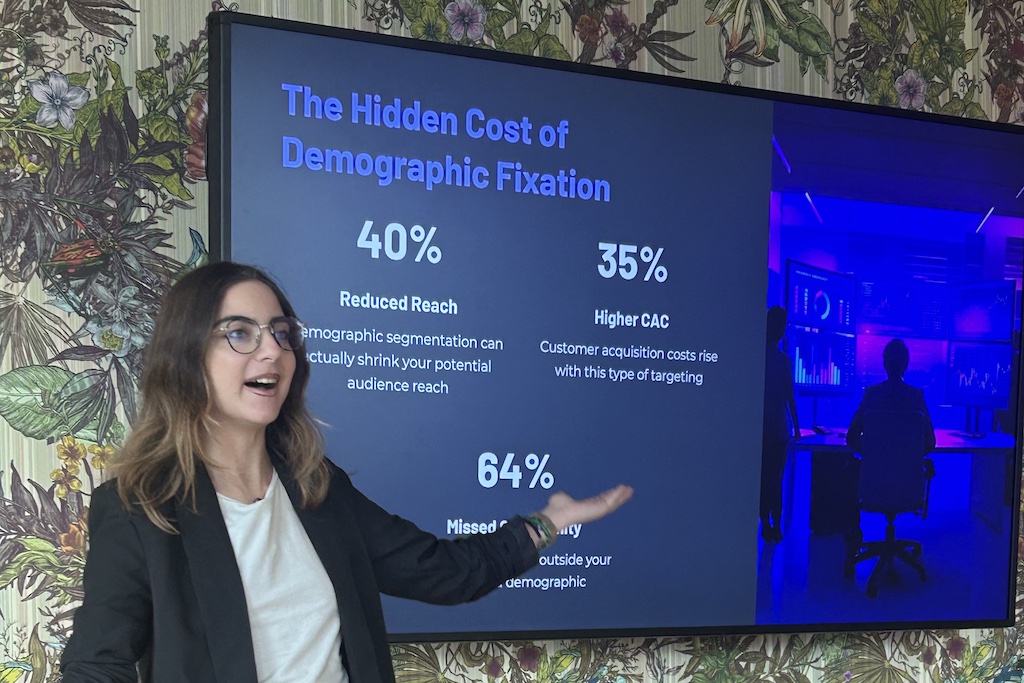At Strata’s recent Making Moments Matter event, behavioural scientist Lea Karam and founder of Mindscope explored how brands can create deeper, more relevant connections with their audiences by moving away from demographic-based segmentation.
In her keynote, she recommended a shift toward behavioural science and emotional insight — arguing that traditional profiling no longer reflects the complexity of modern consumers.
Karam highlighted the wider impact of disengagement in what she called the “distraction economy,” which costs the UK an estimated £20 billion annually. At the heart of this, she argued, is a failure to understand how and why people make decisions.
Here’s some of the key takeaways…
Demographics Are Dead
Demographics such as age, gender or income account for just 18% of purchasing decisions, according to Karam. And yet, many brands still use these categories as the starting point for targeting.
She made the case that demographic data alone fails to explain behaviour, pointing to the example of two individuals such as King Charles and Ozzy Osbourne who may be similar on paper but vastly different in terms of interests, values, and how they engage with content and experiences.
Karam also noted that 62% of people feel brands don’t understand them, suggesting that segmentation by broad labels is not just ineffective but risks alienating the very audiences’ marketers are trying to reach.
“When we rely on demographics, we’re not talking to real people, we’re talking to statistical shadows.”
Behavioural Science is the Future
Instead of focusing on who people are, Karam urged the audience to focus on why people act. Behavioural science offers tools to understand the motivations, emotions, routines and contexts that underpin real decision-making.
Social platforms such as TikTok, Pinterest and Snapchat were highlighted as sources of valuable behavioural signals, not just in terms of content preferences, but in revealing how people discover, evaluate and engage with experiences.
“We’re not in a funnel anymore. We’re in a loop. Awareness and purchase happen simultaneously. The journey is non-linear, fluid, emotional, just like people,” she said.
The Four Pillars of Behavioural Segmentation
To help brands operationalise this thinking, Karam introduced a framework she calls the Four Pillars of Behavioural Segmentation:
- Patterns – habitual behaviours and routines
- Triggers – emotional or situational factors that influence decision-making
- Design – how experiences are shaped and received through tone, visuals and interaction
- Context – the broader emotional or environmental factors affecting people’s choices
“If I’m hungry or stressed, I’m not going to respond the same way,” Karam said. “Context changes everything.”
This model, she explained, creates a more adaptable and human-centred approach to audience insight.
One Size Doesn’t Fit All
Even within tightly defined groups like Gen Z, there is huge variation in values and behaviours said Karam. The mindset of a festival-going Swiftie isn’t the same as a tech-savvy gamer or a self-improvement enthusiast — even if they’re all the same age.
That’s why labels like “millennial” or “young professional” aren’t just lazy — they’re ineffective. They obscure the rich emotional and cultural nuance that makes audiences tick. To connect meaningfully, brands must embrace this complexity and recognise that shared behaviours and values matter more than surface-level similarities.
Design for Emotion, Not Identity
Research shows that emotion drives most consumer choices, and brands that understand this are better positioned to build engagement, loyalty and long-term value.
Designing around emotion means focusing on how people feel before, during and after an experience — and building with meaning, not just functionality.
“We’re irrational. We livestream our meditation retreats. We seek meaning, contradiction, community, and escape — sometimes all at once,” she said.
Creating experiences that honour this emotional complexity is what turns passive audiences into active participants. It’s not about targeting identity — it’s about building shared meaning.
Karam shared a case study where a shift from demographic to motivational targeting led to a 127% uplift in engagement, a 38% drop in acquisition cost, and a 44% increase in customer retention.
Treat People as Co-Creators
Karam closed by emphasising the need to involve audiences as collaborators, not passive recipients.
People no longer want to be spoken at, they want to be involved, heard, and reflected in the experiences they engage with.
She explained how audiences today want to extend their digital identities into the physical world through real-life experiences and cultural connection, a key reason why the experience economy continues to grow.
“People want to be understood, not categorised,” she concluded. “When we design around real behaviours, values and emotions, we build brands that feel human — and experiences that truly connect.”

